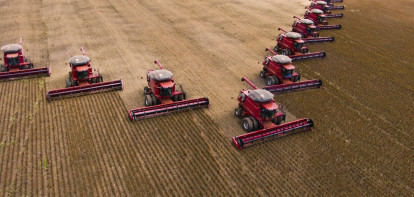Analysis Grains
Wheat in the US is in better condition despite drought
A tender from Egypt did not bring much life to the European wheat trade. In fact, wheat on the Matif had to take a hit. In the US, the harvest is well underway and the vast majority of winter wheat is already in the ground. Despite the drought, winter wheat, according to the USDA, is in better condition than last week. Further south in Brazil, growers have made significant progress with soybeans.
The December contract for wheat on the Matif took a hit yesterday and closed €3.25 lower at €213.75 per ton. On the Chicago exchange, wheat closed ¾ cent higher at $5.68¾ per bushel. Corn saw a slight increase and closed 0.5% higher at $4.16½ per bushel. Soybeans also closed 0.5% higher at $9.87¼ per bushel.
Limited demand for European wheat is putting pressure on prices in Paris. Egypt had a tender open, but European exporters could not compete with their counterparts from Russia and Ukraine. Russia offered a price of $265 per ton FOB (Free On Board). Ukraine was just below that at $263 per ton FOB. As far as is known, the Egyptian state buyer Gasc did not make any purchases in the tender.
Bottom price not successful yet
Ikar has kept the spot price for Russian wheat unchanged from last week at $232 per ton FOB. This keeps the wheat price below the minimum prices set by Russian exporters in conjunction with the Russian Ministry. The minimum price is set at $245 in November and $250 in December. According to SovEcon, Russia's grain exports last week amounted to 1.2 million tons, which is 100,000 tons less than the previous week. The vast majority of last week's grain exports, namely 1.13 million tons, consisted of wheat.
In the US, wheat exports for the week were slightly lower than expected by the market. This had limited impact on the market. Compared to last season, the US has exported 35% more wheat so far, and exports are 17% ahead of the USDA's forecast.
Drought impact limited
Planting of wheat in the US is slightly behind schedule this season. According to this week's new Crop Progress report, 87% of the planned acreage has been planted. This time last year, 88% had been planted, and the five-year average is 89%. Of the planted wheat, 66% is above ground compared to 72% last year. It is noteworthy that the condition of winter wheat has improved compared to last week. 41% of winter wheat is rated good or excellent, up from 38% last week. This is despite the expansion of drought areas in the US. According to the latest drought monitor, 62% of wheat is in a drought area, up from 58% last week.
The harvest of corn and soybeans is well underway in America. According to the Crop Progress report, 91% of corn has been harvested. The five-year average is 75% harvested. American farmers are slightly further along with soybeans, as 94% has been harvested compared to the five-year average of 85%.
Over halfway there
In Brazil, soybean growers have made significant progress in planting soybeans. According to AgRural, 54% of the planned acreage has been planted. Last week, only 18% had been planted. For the first time this season, work is ahead of last year. By this week last year, 51% of the planned soybean acreage had been planted. However, analysts expect work in the fields in Brazil to slow down this week. As Formula 1 fans may have seen, heavy rains passed over the south of Brazil last weekend. While beneficial for crops already in the ground, it will need to dry out a bit before tractors can get back to work, according to local sources.




